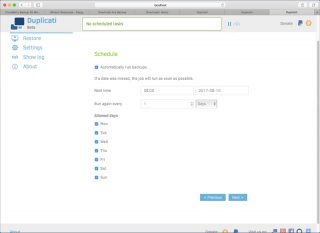
- #Duplicacy vs. arq trial
- #Duplicacy vs. arq password
- #Duplicacy vs. arq license
- #Duplicacy vs. arq mac
Backblaze B2įor the Backblaze B2 storage, the bucket name, the account id, and the application key must be provided. Required, you can click the button next to the private key file text field to select the private key file (which cannot have a blank passphrase due toĪ limitation of the underlying go SSH library).
#Duplicacy vs. arq password
If the SFTP server supports password login, the password used to log into the server must be supplied. If a customer port other than the default 22 is used, enter the server address in the format of host:port. SFTPįor the SFTP storage, the server address, the username, and the remote directory must be specified. If you decide to use a local disk for the storage, you just need to select a directory using the system default dialog.
#Duplicacy vs. arq mac
Being a cloud backup tool, Duplicacy supports many majorĬloud storage providers (and even more are coming), but you can also use local disks or any SFTP servers (such as a Mac or Linux computer, or a NAS box): Local disk Storage SelectionĪfter selecting the repository to be backed up, you need to decide where the backup should be stored. Therefore, the order in which patterns are added is significantįor instance, if you want to exclude all *.log files except the ones under the dir1 directory, the patterns shouldīe +dir1/*.log and -*.log, in that order. If a match is found, the corresponding include or exclude action is taken, For each file or directory, the list of supplied patterns are checked one by one in the given order.So -path1/ will exclude the directory named path1, but not the file with the same name Patterns ending with / are applied to directories only,.

The path separator on Windows is / (not the usual \).Patterns can contain wildcards such as * and ?, as well as the path separator /.An include pattern starts with +, and an exclude pattern starts with.Here are rules for specifying the include/exclude patterns: For more complicated include/exclude patterns,Ĭlick the Include/exclude button and enter one pattern at a time. To exclude a directory, click the Exclude a directory button and select the directory to be excluded. Otherwise, you can add exclude/include patterns so that only certain files or directories will be backed up. The repository, click the Save and you can jump to the next section on storage setup. If you intend to back up everything in the With this dialog, you can click the Choose. This directory is called repository in our terminology.Ĭlick the button next to the text input used to display the repository, and the repository setup dialog will appear: To configure a backup job, the first thing is to select the local directory to be backed up. Alternatively, you can also click the Duplicacy icon in the menu bar (for macOS) or rightĬlick the Duplicacy icon in the system tray (for Windows) to access the same menu. You can right click the tab bar to activate the job management menu toĬreate new jobs or delete existing jobs. Since version 2.1.0, Duplicacy supports multiple backup jobs.

#Duplicacy vs. arq license
Once the appropriate license has been selected, Duplicacy will present the main window with an empty backup job: Personal documents that are not related to for-profit activities.Ī commercial license has no restrictions and can be installed on any computer to back up any files. There are two types of Duplicacy licenses:Ī personal license can only be installed on home computers, and can only be used to back up Licenses can be purchased from our customer page (signup is required).

#Duplicacy vs. arq trial
The first time you run Duplicacy, it will ask you to activate the license or start a fully functional 30-day trial period:


 0 kommentar(er)
0 kommentar(er)
